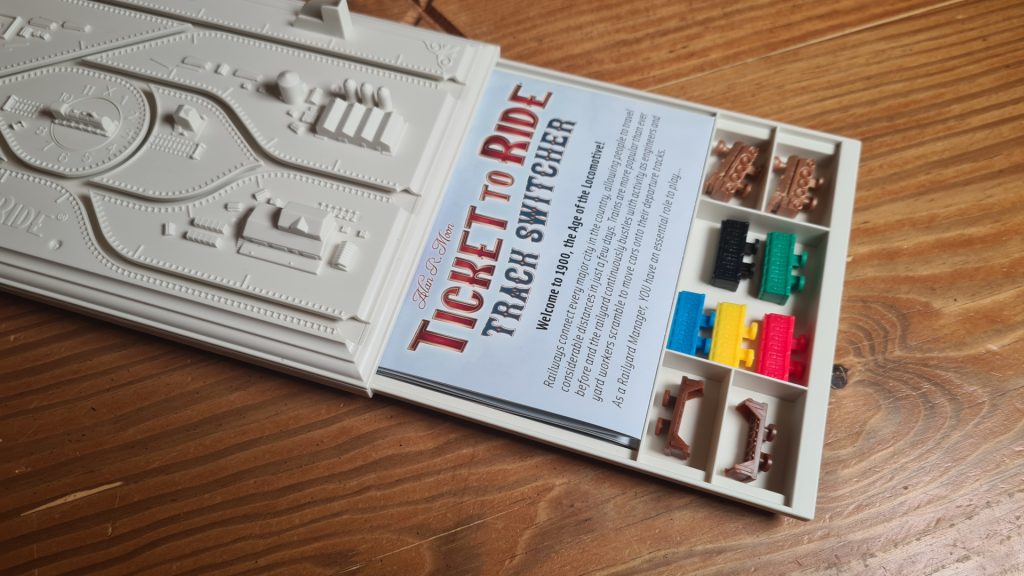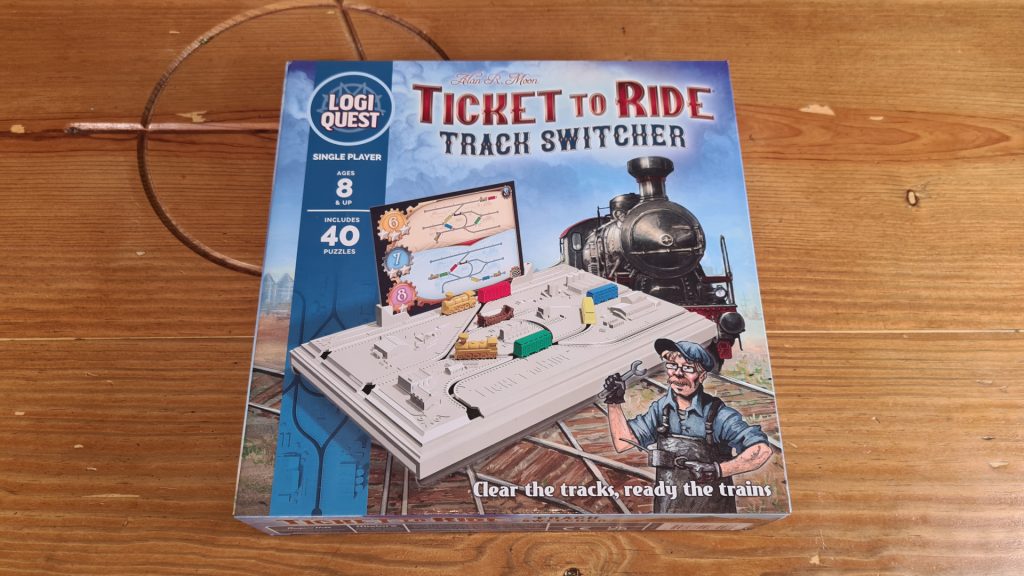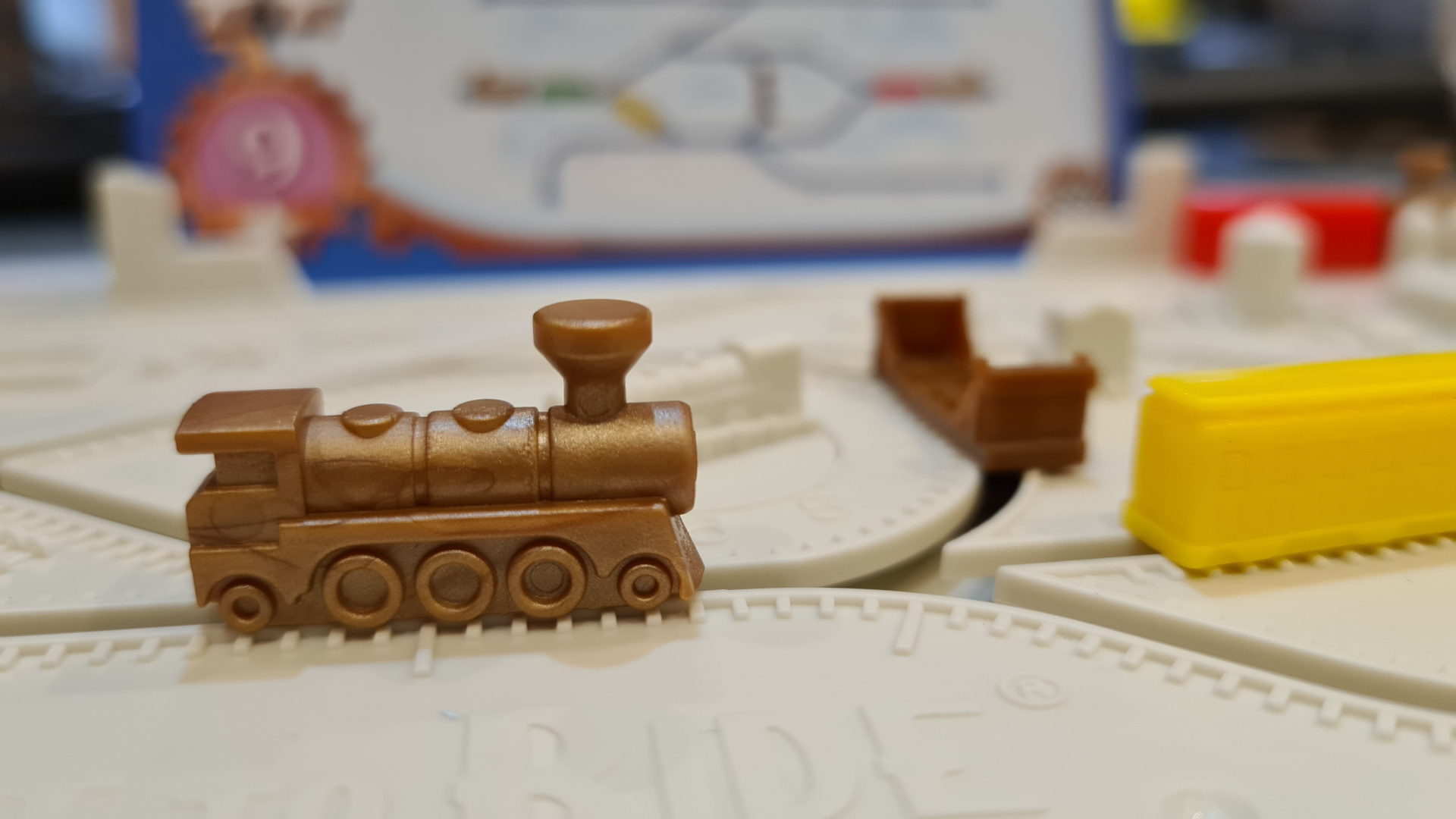Ticket to Ride Track Switcher is the fourth of four puzzle titles from Mixlore’s Logiquest range. We recently got hands on with the Catan themed logic puzzle and now it’s time for another board gaming heavyweight, in the form of Alan R Moon’s Ticket to Ride, to get the puzzle treatment. Unlike the others no marbles run, no shadows will be cast, no hexagons are in sight. Instead, it’s all about moving the trains and carriages around. However, is this the logic puzzle for you? Let’s find out!
Sliding open the Track Switcher self contained box reveals the 5 coloured carriages, 2 trains and two broken track pieces which are used to complete the 40 included puzzles. These puzzles are on the included cards for players to work through. The puzzles are ranked in difficulty from beginner through to master, split at 10 card intervals. While the 40 puzzles are in a numbered order there’s no stopping players jumping between difficulties and completing the puzzles in any order.
Be it a random puzzle or the next numbered one, players start by selecting a puzzle card. On one side it shows the puzzle itself, with the reverse revealing the solution – so no peeking ahead of time. The puzzle side features the starting locations of trains and carriages, which players need to take from the box and put into the indicated spaces on the tracks. Underneath this setup diagram is the aim of the puzzle, the locations which the various carriages and trains need to end up in. Along the side are three skill ranks, awarding a golden victory if the puzzle is completed in the lowest count of moves.
So, what constitutes a move, and what will players be doing as part of the puzzles? As you’d expect, players can only move the trains, not the carriages on their own. Every time a train is moved in one direction until it stops is classed as a move. Between movements a train can couple or uncouple with carriages, bringing them with the train when moved. The train can push carriages also, though it can only couple and pull a carriage that’s behind it.

To count the moves taken, while it can initially be easy to count them, the player can use the turntable tracker on the board. When a puzzle is completed the player compares the number of moves spent with the skill rank moves. If it’s within range then the puzzle is completed, though the player can try again if they believe another attempt would let them beat the puzzle card at the gold level. If the player took more moves to do the puzzle than even the bronze level then they must try again.
Once complete the player can flip the card over to reveal the optimal method for solving the puzzle. Note that this only shows the gold level solution, so will otherwise be unable to confirm your method as correct. With one puzzle down it is then onto the next, sliding the puzzle pieces off and choosing a new card to attempt.
With Zip City and the Catan Logic Puzzle the player was attempting to determine routes. Ticket to Ride Track Switcher is similar, yet slightly different. Instead of a single route the trains will have to push and pull carriages back and forth, to get them into the right positions: traveling along the possible routes.
Despite the track layout not changing, the locations and orientations of the puzzle pieces do change. While some puzzles are similar, perhaps utilizing the loop section in the same way to spin a train around, each is subtly different. Over a few puzzles the player can get on a bit of a roll, then the game ramps up. This is done slowly across the 4 difficulty modes, though also through the gradual introduction of components. Suddenly a second train is involved, then a section of the track is split off by the broken track pieces. Each element adds to the puzzles and adds to the challenge.

Unlike the Zip City or Shadow Glyphs Logiquest puzzles, the Ticket to Ride Track Switcher set includes no hints. This means that players either solve the puzzle or are presented straight away with the answer. It would have been nice to see perhaps the first move as a hint, so when stumped by a puzzle it isn’t completely spoiled by the full answer being revealed. Technically, players can briefly flip the card over and back again to just glimpse the top line of the answer – though this is far from a perfect solution. In part a silver lining to the way the answers are awfully detailed is that it makes it hard to visualize many moves from the solution at a glance.
Thankfully, a layout card is included that works with the puzzle cards, indicating a letter for each node where the trains can stop. An answer section may say for example, in iconography form, move the train from A to E, while coupled and pulling the blue carriage. There’s two ways that the solution side could have been dramatically improved, letters on the track or diagrams on the reverse of the puzzle cards. How neither of these methods was realized or used baffles me more than most of the included puzzles.
Ticket to Ride Track Switcher offers 40 unique puzzles for players to work through. Unlike the other games in the Logiquest line-up, whilst there was a sense of satisfaction at completing a puzzle, there wasn’t always the draw to continue playing on. Nevertheless, there’s something about the puzzles which when you’ve started one you strive for the golden skill on it, not content with just beating it. Offering solid puzzles, Ticket to Ride Track Switcher could still be the solo puzzle you’re looking for, especially if you like the train yard theme.
(Editor’s Note: Ticket to Ride Track Switcher was provided to us by Asmodee for the review. The game is currently available from local board game stores! Find your local store here.)

